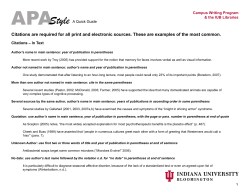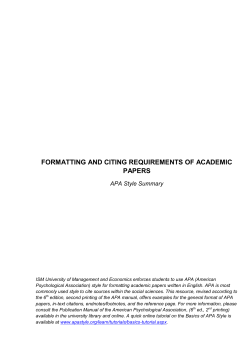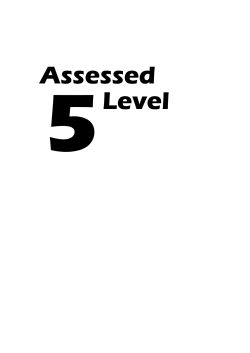
1 materials Objective Teaching the Lesson
Objective 1 To review the use of parentheses. materials Teaching the Lesson Key Activities Students use parentheses in number sentences involving more than one operation. They translate number stories into number sentences, inserting parentheses in the proper places, and determine whether number sentences containing parentheses are true or false. Key Concepts and Skills Math Journal 2, pp. 219 and 220 Study Link 7 3 Teaching Aid Master (Math Masters, p. 414; optional) slates • Identify and write sentences that model number stories. [Patterns, Functions, and Algebra Goal 2] • Solve problems involving parentheses and nested parentheses. [Patterns, Functions, and Algebra Goal 2] • Insert parentheses in order to make true number sentences. [Patterns, Functions, and Algebra Goal 2] Key Vocabulary expression • ambiguous • nested parentheses Ongoing Assessment: Recognizing Student Achievement Use journal page 220. [Patterns, Functions, and Algebra Goal 3] 2 materials Ongoing Learning & Practice Students play Name That Number. Students practice and maintain skills through Math Boxes and Study Link activities. 3 materials Differentiation Options READINESS Students insert parentheses to make number sentences true. ENRICHMENT Students partition dot grids and use the patterns to write number models. Math Journal 2, p. 221 Student Reference Book, p. 325 Study Link Master (Math Masters, p. 197) Per partnership: 1 complete deck of number cards, (from the Everything Math Deck, if available) EXTRA PRACTICE Students practice using grouping symbols. Teaching Masters (Math Masters, pp. 198 and 199) 5-Minute Math, pp. 77, 78 Technology Assessment Management System Journal page 220 See the iTLG. Lesson 7 4 557 Getting Started Mental Math and Reflexes Math Message Have students supply the missing decimal for dictated phrases. Suggestions: 11 tens equal 1.1 hundreds 26 hundreds equal 2.6 thousands 142 hundreds equal 14.2 thousands 3 million 5 hundred-thousands equal 3.5 millions 45 tens equal 4.5 hundreds 13 hundreds equal 1.3 thousands 6 hundreds equal 0.6 thousands 100 thousands equal 0.1 million 155 hundreds equal 15.5 thousands Complete Problems 1 and 2 at the top of journal page 219. Study Link 7 3 Follow-Up Have partners compare answers and resolve differences. 1 Teaching the Lesson Math Message Follow-Up WHOLE-CLASS ACTIVITY (Math Journal 2, p. 219) Discuss students’ answers. Ask: What do parentheses mean in number sentences? Operations inside parentheses are done first. Write the number sentences from Problem 1 on the board, with their answers, but without parentheses. Guide students to see that without the mathematical punctuation of parentheses, number expressions can take on different values depending on the order in which the operations are performed. Without parentheses, the expression is said to be ambiguous because it has more than one possible meaning. Student Page Date LESSON 74 NOTE An expression is a group of mathematical symbols (numbers, operation Time signs, variables, grouping symbols) that represents a number—or can represent a number if values are assigned to any variables it contains. A number sentence is made up of at least two numbers or expressions separated by a relation symbol such as , , or . Parentheses and Number Stories Math Message 1. Make a true sentence by filling in the missing number. a. 7 (2 1) b. (7 2) 1 4 6 c. 2.0 (7.5 1.5) d. (2.0 7.5) 1.5 Example: The number sentence 6 4 2 / 2 n includes the expression 6 4 2 / 2, the variable n, and the equal symbol . 18 16.5 2. Insert parentheses to rewrite the following problem in as many different true Ask volunteers to share their answers to Problem 2 and explain the steps they used to solve the problem. As the students explain the steps, list them on the board. For example: sentences as possible. 642/2? ((6 4)) 2) / 2 11 6 (4 2) / 2 6 (6 4) (2 / 2) 23 6 (4 (2 / 2)) 18 Steps Draw a line to match each number story with the expression that fits it. 3. Story 1 Tom had 4 cans of soda. He went shopping and bought 3 six-packs of soda cans. (4 3) 6 Story 2 Tom had 4 six-packs of soda cans. He went shopping and bought 3 more six-packs of soda cans. 4 (3 6) 219 Math Journal 2, p. 219 558 Numerical Expression Tom’s Total Number of Soda Cans Unit 7 Exponents and Negative Numbers 4 Multiply 6 times 4. 6 Subtract 2 from the result. (6 Divide that result by 2. ((6 4) 2 4) 2) / 2 Student Page Point out that when two or more sets of parentheses are used in the same expression, the operation inside the inner parentheses is done first. In ((6 4) 2) / 2, 6 times 4 is the operation in the inner parentheses. The operation in the outer parentheses is done next, followed by all the remaining operations. Parentheses inside parentheses are referred to as nested parentheses. Date Time LESSON Parentheses and Number Stories 74 4. Story 1 3 (45 / 5) Alice ate 3 cookies before going to a party. At the party, Alice and 4 friends ate equal shares of 45 cookies. Story 2 (45 3) / 5 There was a full bag with 45 cookies and an opened bag with 3 cookies. Alice and 4 friends ate equal shares of all these cookies. 5. Story 1 Number of Cookies Baked 15 (4 5) Mr. Chung baked 5 batches of cookies. Each of the first 4 batches contained 15 cookies. The final batch contained only 5 cookies. Links to the Future This lesson stresses the use of parentheses to create unambiguous expressions. Lesson 7-5 will introduce the conventional order of operations, which often reduces or eliminates the need for grouping symbols in many number sentences. continued Number of Cookies Alice Ate Story 2 (4 15) 5 In the morning, Mr. Chung baked 4 batches of 15 cookies each. In the afternoon, he baked 5 more batches of 15 cookies each. 6. A grocery store received a shipment of 120 cases of apple juice. Each case contained 4 six-packs of cans. After inspection, the store found that 9 cans were damaged. Write an expression that represents the number of undamaged cans. Matching Number Stories Sample answer: (120 (4 6)) 9 PARTNER ACTIVITY to Appropriate Expressions (Math Journal 2, pp. 219 and 220) Ask students to read the two number stories in Problem 3 on journal page 219 and match each story with an expression. Ask volunteers to explain their choices. Story 1 goes with the second expression since 3 must be multiplied by 6 to find the total number of cans in 3 six-packs. Story 2 goes with the first expression since 4 3 stands for the total number of six-packs. Math Journal 2, p. 220 Assign journal page 220. When most students are done, bring the class together and go over the answers. Have students explain their reasons for matching a given number story with a particular expression. Ongoing Assessment: Recognizing Student Achievement Journal Page 220 Problem 6 Use journal page 220, Problem 6 to assess students’ facility with writing expressions containing parentheses to represent a number story. Have students complete an Exit Slip (Math Masters, page 414) for the following: Explain how you used parentheses in Problem 6 on journal page 220 to write the expression for the total number of undamaged cans. Students are making adequate progress if they refer to the use of nested parentheses to identify the total number of undamaged cans. [Patterns, Functions, and Algebra Goal 3] Student Page Games Name That Number Materials 1 complete deck of number cards Players 2 or 3 Skill Naming numbers with expressions Object of the game To collect the most cards. Directions 1. Shuffle the deck and deal 5 cards to each player. Place the remaining cards number-side down on the table between the players. Turn over the top card and place it beside the deck. This is the target number for the round. 2. Players try to match the target number by adding, subtracting, multiplying, or dividing the numbers on as many of their cards as possible. A card may only be used once. 3. Players write their solutions on a sheet of paper. When players have written their best solutions: ♦ Each player sets aside the cards they used to match the target number. ♦ Each player replaces the cards they set aside by drawing new cards from the top of the deck. Target number: 16 Player 1’s cards: 7 5 8 5 7 (Student Reference Book, p. 325) Example 2 8 PARTNER ACTIVITY 10 2 Playing Name That Number is played. 4. Play continues until there are not enough cards left to replace all of the players’ cards. The player who has set aside the most cards wins the game. 10 2 Ongoing Learning & Practice ♦ The old target number is placed on the bottom of the deck. ♦ A new target number is turned over, and another round Some possible solutions: 10 8 2 16 (3 cards used) Students practice applying number properties, equivalent names, arithmetic operations, and basic facts by playing Name That 7 * 2 10 8 16 (4 cards used) 8 / 2 10 7 5 16 (all 5 cards used) The player sets aside the cards used to make a solution and draws the same number of cards from the top of the deck. Student Reference Book, p. 325 Lesson 7 4 559 Student Page Date Time LESSON Number. Encourage students to extend the game by using the cards in their hands to form exponents and/or fractions. Math Boxes 74 1. Measure the length and width of each of the following objects to the nearest half inch. a. journal cover length 10 78 in. width Answers vary for b–d. 812 in. length c. index card length in. width width in. length 2. a. Make a stem-and-leaf plot of the INDEPENDENT ACTIVITY (Math Journal 2, p. 221) in. 165 154 Range: 31 Mode(s): 165,170 Mixed Practice Math Boxes in this lesson are paired with Math Boxes in Lessons 7-2 and 7-6. The skill in Problem 4 previews Unit 8 content. 478 3555 0059 5 117–119 3. Measure M to the nearest degree. 4. Calculate the sale price. M M measures about width Minimum: Leaves (1s) 4 2 0 2 in. Median: 163, 179, 170, 165, 182, 157, 154, 165, 170, 175, 162, 185, 158, 170, 165, 154 15 16 17 18 b. Find the following landmarks for the data. hand-span measures in Ms. Grip’s fifth-grade class. Stems (100s and 10s) Math Boxes 7 4 in. (your choice) d. in. 183 b. desktop 167 . 204 Regular Price Discount $8.99 20% $11.99 25% $89.00 20% $9.99 20% Sale Price $7.19 $8.99 $71.20 $7.99 Writing/Reasoning Have students write a response to the following: Use your solution for Problem 2 to explain how to read a stem-and-leaf plot. Sample answer: In this problem, the stems are the hundreds and tens digits for each number, and the leaves are the ones digits. The first number on this stem-and-leaf plot has 1 in the hundreds place, 5 in the tens place, and 4 in the ones place. It is read one hundred fifty-four. 51 221 Math Journal 2, p. 221 Study Link 7 4 INDEPENDENT ACTIVITY (Math Masters, p. 197) Home Connection Students insert parentheses to make number sentences true. In several cases, students will need to insert nested parentheses. 3 Differentiation Options READINESS Study Link Master Name Date STUDY LINK 74 4. 2 =(3 2)(4 / 1) 2. 3 =(4 3 1) / 2 Write seven names for 8. Use only numbers less than 10, and use at least three different operations in each name. Use parentheses. Follow the directions in Problem 7 to fill in the last two rows. Reminder: When you have a pair of parentheses inside another pair, the parentheses are called nested parentheses. Example: 8 ((5 6) 2) / 4 5. 7. 1 ((4 1) 3) / 2 6. Sample answers for Problems 1–6: 3. 4 (3 1) (4 / 2) 8 Make each sentence true by inserting parentheses. (9 1) (1 / 1) (9 5) (2 2) (0.5 / 1) (2.5 3) (6.3 9.7) / (6 4) (6.2 / 2) (7 2.1) 1 (2 8) (9 5) (72 9) 5 (42 (3 3)) 1 ((2 1)4 9) 1 7 ((4 3) / 2) 1 Add two names to your name-collection box in Problem 4. Use nested parentheses. Practice Find the number that each variable represents. 4 1 112 , or 13 9. (11 p) 22 12 5 1 8. 2 (1 a) a 2 12 12 2 1 28, or 24 5 15 2 10. 6 d 7 d 11. 6.4 y 6 8 8 5 1 p 12 y0 Math Masters, p. 197 560 15–30 Min Number Sentences 222 223 Make each sentence true by inserting parentheses. 1. Reviewing Parentheses in Time Using Parentheses PARTNER ACTIVITY Unit 7 Exponents and Negative Numbers (Math Masters, p. 198) To explore the use of parentheses in number sentences, have students insert parentheses to make true sentences. Students compare the use of commas in text sentences to the use of parentheses in number sentences. When students have finished the page, have them share why they think parentheses are important. Teaching Master ENRICHMENT Describing Dot Patterns INDEPENDENT ACTIVITY Name with Number Models Time Reviewing Parentheses 74 Read the following sentence. Mary Grace the lizard ate three crickets. 1. 15–30 Min Date LESSON This sentence could have multiple meanings. 1. The speaker is telling someone named Mary Grace that the lizard ate three crickets. (Math Masters, p. 199) 2. The lizard, named Mary Grace, ate three crickets. 3. The speaker is telling someone named Mary that the lizard, named Grace, ate three crickets. To apply students’ understanding of parentheses, have them write number sentences to describe dot patterns. Students partition a dot grid and write number sentences to model the indicated number patterns. Without commas, it’s hard to tell which meaning was intended. Write the number of the meaning next to each sentence below. a. b. c. 5-Minute Math Mary Grace, the lizard ate three crickets. Mary, Grace the lizard, ate three crickets. Insert parentheses in each sentence to make the sentence true. SMALL-GROUP ACTIVITY 3 (4 7) 33 6 (9 5) 51 27 / 4 5 6 9 27 / (4 5) 6 9 a. 3 4 7 33 b. 6 9 5 51 c. 5–15 Min Insert parentheses in the expressions below, and find their solutions. 3. To offer students more experience with grouping symbols, see 5-Minute Math, pages 77 and 78. Planning Ahead Mary Grace, the lizard, ate three crickets. By adding commas, the meaning of a sentence becomes clear. In number sentences, parentheses are used to indicate what to calculate first. 2. EXTRA PRACTICE 2 1 3 a. 754 b. 693 (7 5) 4 31; 7 (5 4) 7 (6 9) 3 5; 6 (9 3) 9 Math Masters, p. 198 In Lesson 7-6, you will need newspapers and magazines that contain line graphs. Teaching Master Name LESSON 74 Date Time Describing Dot Patterns The total dots in this dot array can be found by using patterns. Here is one way to find the total: ((3 3) (4 3) 4) Use shape outlines or colors to identify a pattern on this dot array. Write a number model for your pattern. Then write a number story that matches your number model. Sample answers: Number model: (11 11) (4 (5 4)) (12 4) (4 4) 265 Number story: Sample answer: In a large city school, the fifth graders fill the auditorium in colorful choir robes. Students wearing purple robes stand in 11 rows of 11 students each. Four groups in gold robes stand in 4 rows of 5 students each. There are 4 groups of 12 students in black robes and 4 groups of 4 students in green robes. How many students are in the auditorium? Math Masters, p. 199 Lesson 7 4 561
© Copyright 2025










